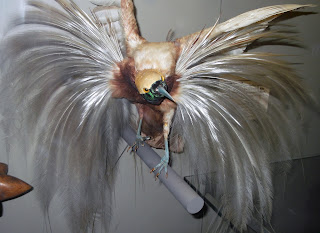Here are some designs that I have chosen as my final samples.
This design was initially inspired by a chevron pattern. I used two different feathers, alternating between a stroke and a fill, in place of lines or dashes. I then filled the spaces in between with taxidermist's tools. This pattern is quite simple in contrast to some other prints but I would like a variation in my final collection.
This is possibly my favourite print so far. However, when I've digitally printed it on to cotton sateen the background looks too plain. It could maybe do with some texture or a light subtle print so that it doesn't distract from the main imagery.
I like that it is still hinting at the theme of taxidermy due to the tag, labels, tools and skulls. However, the colours mean that it doesn't look as gruesome as stuffed and preserved animals would imply.
This print was inspired by the work of Flora and Fauna. The background is a light grey so that the bright birds stand out against it. I also added a small highlight of green in the arrow.
My colour palette has been a problem for me throughout this project. I started off with a small palette of light blue, dark blue, grey, brown, orange and white. I found that this palette wasn't big enough to use for some of the repeat patterns that I was doing at the beginning. I got a new bright palette from WGSN and replaced some of the colours in it for the white, peach and grey from the original palette. I think its working better now but colour is still not my forte.

































